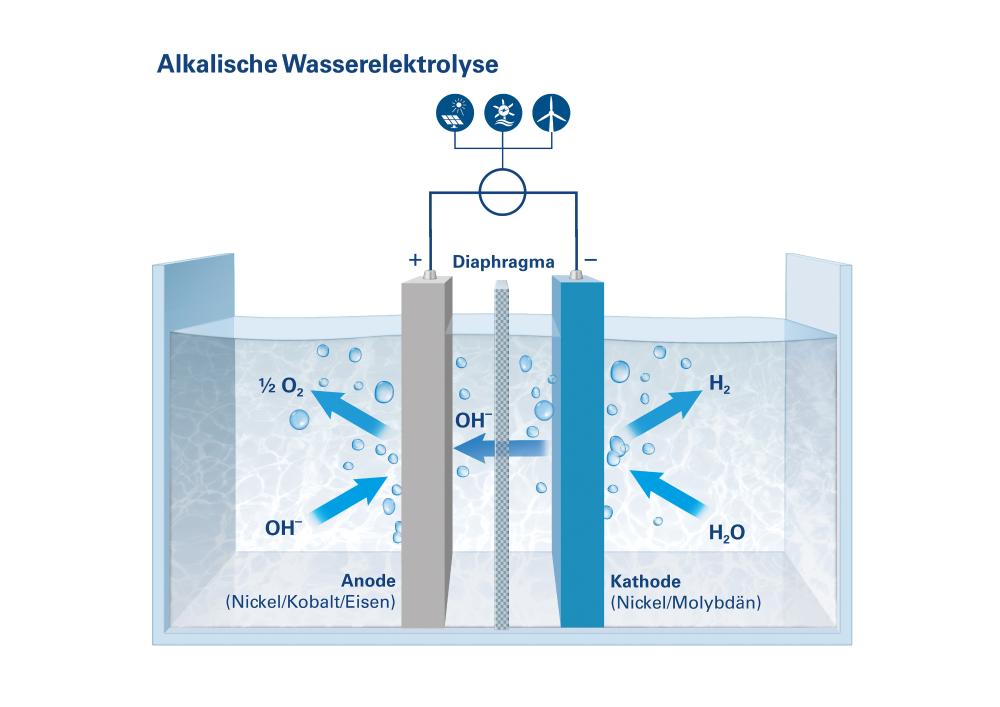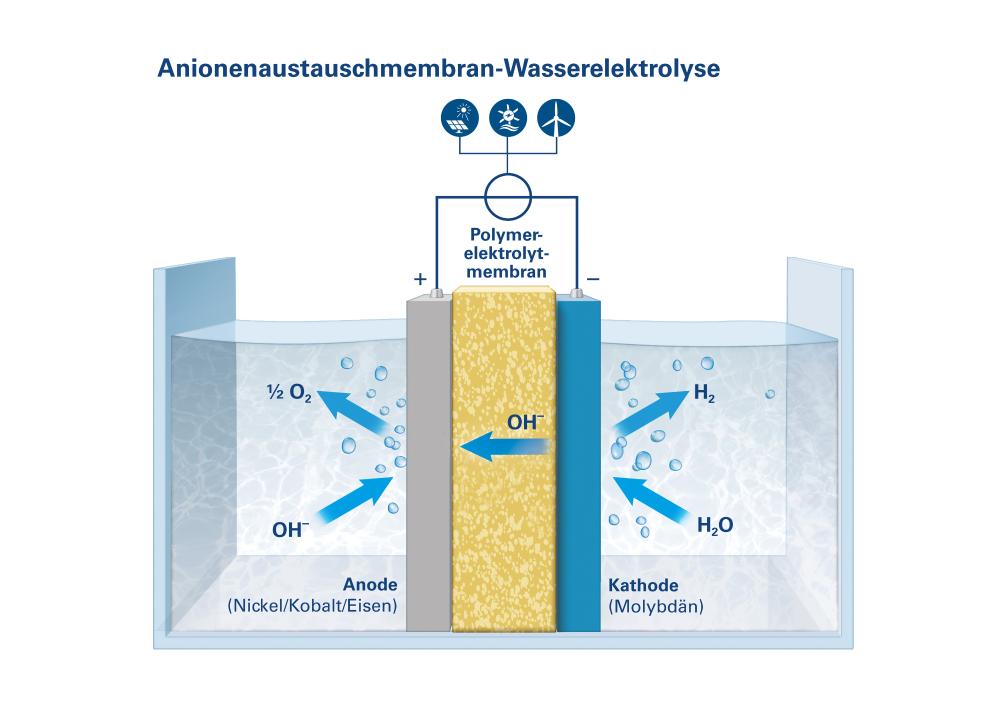Wasserstoff-Fakten - Hydrogen
Breadcrumb
Banner Fakten
Fakten
Die „Farben“ von Wasserstoff, seine nachhaltige Herstellung und seine Rolle in der Energiewende.
Wasserstoff-Farben
Wasserstoff-Farben: Bunte Vielfalt
Wasserstoff ist nicht gleich Wasserstoff – Farben spielen bei seiner Klassifizierung eine entscheidende Rolle.
CO2-neutral erzeugter Wasserstoff ist das Mittel der Wahl, um Klimaneutralität in industriellen Prozessen und Produktionen sowie bei Logistikprozessen und im öffentlichen Nahverkehr zu erreichen.
-
Grüner Wasserstoff...
-
Grauer Wasserstoff...
-
Blauer Wasserstoff...
-
Türkiser Wasserstoff...
-
Pinkfarbener Wasserstoff...
-
Oranger Wasserstoff...
... auch erneuerbarer Wasserstoff genannt, wird durch Elektrolyse von Wasser hergestellt, wobei der dafür benötigte Strom ausschließlich aus erneuerbaren Energiequellen stammen darf. Damit ist seine Produktion CO2-neutral.
... wird aus fossilen Brennstoffen gewonnen, in der Regel aus Erdgas. Im dabei genutzten Verfahren der Dampfreformierung entsteht auch CO2, das ungenutzt in die Atmosphäre entweicht. Die Produktion einer Tonne Wasserstoff verursacht etwa zehn Tonnen CO2.
... ist prinzipiell grauer Wasserstoff, wobei das CO2 bei der Entstehung abgeschieden und dauerhaft in geologischen Formationen gespeichert wird (engl. Carbon Capture and Storage, CCS) oder in anderen Anwendungen Verwendung findet, z. B. in Baustoffen (engl. Carbon Capture and Utilization, CCU). Da das CO2 nicht in die Atmosphäre gelangt, gilt die Produktion blauen Wasserstoffs als CO2-neutral.
... stammt aus der thermischen Spaltung von Methan (Methanpyrolyse). Anstelle von CO2 entsteht fester Kohlenstoff. Damit türkiser Wasserstoff als CO2-neutral gelten darf, muss die Wärmeversorgung des Hochtemperaturreaktors aus erneuerbaren Energiequellen stammen und der Kohlenstoff dauerhaft gebunden werden – es sei denn, das Methan stammt aus biogenen Quellen.
... wird ebenfalls aus der Elektrolyse von Wasser hergestellt, der dafür eingesetzte Strom stammt jedoch aus Atomkraftwerken. Da keine CO2-Emissionen entstehen, gilt die Produktion von pinkfarbenem Wasserstoff als klimaneutral.
... wird aus Biomasse oder mit Strom aus der Abfallwirtschaft, beispielsweise aus Müllverbrennungsanlagen oder Biogasanlagen, erzeugt.
Wasserstoff-Herstellung: Elektrolyse von Wasser Teil 1/2
Wasserstoff-Herstellung: Elektrolyse von Wasser
Ob als Energiespeicher, Kraftstoff oder Grundstoff für chemische Prozesse – grüner Wasserstoff gilt als ultimativer Energieträger der Zukunft. Um sauberen Wasserstoff zu erzeugen, kommt die Niedertemperatur-Wasserelektrolyse zum Einsatz, bei der drei grundsätzliche Verfahren unterschieden werden:
Akkordeon - Wasserstoff-Herstellung: Elektrolyse von Wasser
Alkalische Wasserelektrolyse (AWE)
AWE – das Arbeitspferd unter den Wasserelektrolyseverfahren
Bei der alkalischen Wasserelektrolyse (AWE) werden zwei Elektroden in einen flüssigen Elektrolyten eingetaucht, der üblicherweise eine stark konzentrierte wässrige Kaliumhydroxid-Lösung ist. Anoden- und Kathodenraum der Elektrolysezelle werden von einem Diaphragma getrennt, das den Transport von Hydroxidionen zwischen der Anode und der Kathode gewährleistet. Das Diaphragma muss zusätzlich elektrisch isolieren und für die Produktgase undurchlässig sein. An der Kathode spalten sich Wassermoleküle in Wasserstoff und Hydroxidionen. Der Wasserstoff steigt als Gas auf, die Hydroxidionen wandern durch die Lauge zur Anode, wo sie zu Wasser und Sauerstoff reagieren. Die AWE ist eine robuste Technologie, die mit vergleichsweise preiswerten Materialien für die Elektrolysezellen auskommt. Die Katalysatoren, dank derer die Reaktionen in Gang kommen, enthalten zum Beispiel Nickel, Kobalt und Eisen, während andere Zellenkomponenten aus Edelstahl bestehen.

Polymerelektrolytmembran-Wasserelektrolyse (PEMWE)
PEMWE – kompakt, dynamisch und ohne externe Verdichtung
Bei der Polymerelektrolytmembran-Wasserelektrolyse (PEMWE) hat die Membran nicht nur die Funktion einer Trennwand. Sie ersetzt vielmehr die Elektrolytflüssigkeit, weil sie aus einem ionenleitfähigen Polymer besteht, durch das einfach geladene Protonen wandern können. Die Elektroden liegen direkt auf der Membran auf. Das zu spaltende Wasser fließt zur Anode, die freigesetzten Wasserstoffionen wandern von der Anode durch die Membran auf die Kathodenseite, wo sie sich zu Wasserstoffmolekülen vereinen. Ein PEM-Elektrolyseur wird bei höheren Stromdichten betrieben als ein AWE-System und kann auch schnellere Lastwechsel aufnehmen. Weitere Vorteile sind das kompaktere Design, der dynamische Betrieb und die Möglichkeit, Wasserstoff ohne externe Verdichtung unter hohem Druck herzustellen. Dafür werden hochpreisigere Materialien benötigt: Platin und Iridium für die Katalysatoren, Titan für die Elektrolysezellen.

Anionenaustauschmembran-Wasserelektrolyse (AEMWE)
AEMWE – Verfahren mit Zukunftspotenzial
Ein drittes Verfahren, die Anionenaustauschmembran-Wasserelektrolyse (AEMWE), befindet sich derzeit in der Entwicklung und bietet Zukunftspotenzial, da sie die Vorteile der beiden etablierten Technologien verbindet: Preiswerte, leicht verfügbare Materialien in einem kompakten Apparat, der Wasserstoff unter hohem Druck erzeugt.

Wasserstoff-Herstellung: Elektrolyse von Wasser Teil 2/2
Für die industrielle Wasserstoffproduktion haben sich die alkalische Wasserelektrolyse und die Polymerelektrolytmembran-Wasserelektrolyse bereits etabliert. Im direkten Vergleich bietet letztere zahlreiche Vorzüge, weshalb Messer das PEMWE-Verfahren bevorzugt.
Neben den beiden etablierten Verfahren werden derzeit der industrielle Einsatz der Anionenaustauschmembran-Wasserelektrolyse (AEMWE) sowie der Hochtemperatur-Elektrolyse namens Solid Oxide Electrolysis (SOEL) untersucht.
Wasserstoff-Politik: Definierte Klimaziele
Wasserstoff-Politik: Definierte Klimaziele
Weltweit gibt es Bestrebungen, der fortschreitenden Erwärmung der Erdatmosphäre und dem damit verbundenen Klimawandel zu begegnen.
Die Europäische Union will erster klimaneutraler Kontinent werden. Konkret sieht der europäische „Green Deal“ vor, bis 2050 keine Netto-Treibhausgase mehr auszustoßen. Deutschland plant, die Klimaneutralität 2045 zu erreichen. Die USA wollen den Ausstoß von klimaschädlichem CO2 bis 2030 im Vergleich zu 2005 halbieren und spätestens ab 2050 klimaneutral sein. Auch China bekennt sich zu den Zielen des Pariser Klimaabkommens.
Seit 2019 orientiert sich das Familienunternehmen Messer an den UN-Sustainable Development Goals. Durch eine bessere Auslastung der vorhandenen Produktionsanlagen und zielgerichtete Projekte, die die Energieeffizienz der Anlagen nachhaltig steigern, soll der spezifische Energieverbrauch Messer-eigener Luftzerlegungsanlagen immer weiter reduziert werden. Hierfür hat Messer sich bis zum Jahr 2025 eine Senkung um 0,7 Prozent pro Jahr zum Ziel gesetzt; dies ergibt in Summe eine Reduktion um knapp 3,5 Prozent. Zudem leistet Messer durch die zunehmende Nutzung von erneuerbaren Energieformen einen weiteren, wesentlichen Beitrag zur Dekarbonisierung.
In Europa spielt die Wasserstoffstrategie der Europäischen Kommission (2020) eine wichtige Rolle bei der Dekarbonisierung von Transport und Industrie. Bis 2024 sollen 6 GW Elektrolyseleistung entstehen, bis 2030 40 GW Elektrolyseleistung. Im Rahmen des so genannten ‚Fit for 55‘ Maßnahmenpakets (2021) werden u. a. Ziele für den Einsatz von erneuerbarem Wasserstoff vorgeschlagen: bis 2030 2,6 % im Bereich Transport und 50 % in der Industrie. Der Bedarf an Wasserstoff soll hauptsächlich mit Hilfe der Wasser-Elektrolyse gedeckt werden.
Steigende EUA-Preise, verschärfte Rahmenbedingungen beim CO2-Emissionshandel sowie Anreize zur Umstellung auf saubere Antriebe, u. a. im ÖPNV, sind weitere Kriterien für Investitionsentscheidungen in Richtung Klimaneutralität.
Um Wirtschaft und Unternehmen auf diesem Weg zu unterstützen, steht Messer mit anwendungstechnischer Expertise und Produkten – einschließlich sauberem Wasserstoff – bereit. Durch unsere Präsenz in Europa, USA und Asien kennen wir zudem die jeweiligen staatlichen Programme zur Förderungen von sauberen Wasserstoff-Projekten und unterstützen dabei, die damit verbundenen Möglichkeiten zu nutzen.
